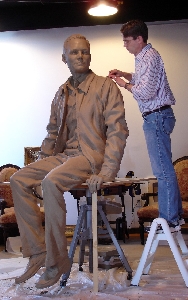
Contact: Emil Venere, 765-494-4709, venere@purdue.edu; Chas Fagan, 980-321-0532, chasfagan@aol.com; Leah H. Jamieson, John A. Edwardson Dean of Engineering, 765-494-5346, lhj@purdue.edu; Photos and video will be available the day of the event
WEST LAFAYETTE, Ind., Oct. 26 /Standard Newswire/ -- Purdue University will unveil a bronze sculpture of alumnus Neil Armstrong at 10 a.m. Friday (Oct. 26) as a prelude to Saturday's (Oct. 27) dedication ceremony for a new engineering research and education building named for the first astronaut to walk on the moon.
Photo: Artist Chas Fagan, from
The statue, accompanied by a trail of sculpted moon boot impressions and other symbolic features, is situated in front of the new Neil Armstrong Hall of Engineering, located at Stadium and Northwestern avenues on Purdue's
Artist Chas Fagan, from
"When our students see this sculpture, I hope they'll believe that they, like Mr. Armstrong, can achieve the unimaginable," said Purdue President France A. Cordova. "I hope it will inspire them to reach for the stars."
The bronze statue, an 8-foot-tall, 125 percent scale likeness of Armstrong, recreates the image of a clean-cut college student wearing a windbreaker, button-down
Mary Jo Kirk and her husband, Purdue alumnus Bob Kirk of
An elliptical stone arc resembling a spacecraft trajectory is embedded flush with the ground in
The arc leads toward the lunar footprints, which were molded from an impression made using a moon boot provided by the Smithsonian Air and
Fagan said the sculpture presented several challenges.
"The moon boot prints are definitely an interesting feature," Fagan said. "Now students are really able to walk in the footsteps of Neil Armstrong."
Fagan consulted with Armstrong to ensure that he was on the right track before creating the sculpture's final design.
"I met with him privately so that I could ask him for input and get his perspective of what he was like as an engineering student at Purdue," Fagan said. "He reviewed details and made suggestions, and the design was approved by committee."
Fagan also had to meet with his subject to solve a key missing ingredient: He needed to know what Armstrong's profile looked like.
"I took photos that clearly showed his profile because none existed," Fagan said. "The age difference did not really matter because bone structure and basic features don't change. Without knowing someone's profile, you are just guessing, based on shadows you see in non-profile photographs, as to how the person looks in real life."
Armstrong also provided materials for the sculptor to work with, including photographs from family albums, his slide rule and original Purdue notebooks, said Fagan, an internationally known artist whose work adorns the National Cathedral in
Armstrong earned a bachelor's degree from Purdue's
Armstrong is a retired chairman of the EDO Corp., an electronics and aerospace manufacturer.
Mary Jo Kirk has lived in
Bob Kirk, a retired chairman of British Aerospace Holdings Inc., the
In recent years, Bob Kirk has served as a member of the board of directors of such companies as Harsco Corp. and First Aviation Services Inc. He also has served on the Defense Industry Advisory Council Committee on Military Experts, and he was a charter member of the U.S. Delegation of the NATO Industrial Advisory Group.
The unveiling is part of a two-week celebration leading up to Purdue's Homecoming on Oct. 27. The events focus on how Purdue is improving education and the quality of life.




 Sign Up to Receive Press Releases:
Sign Up to Receive Press Releases: